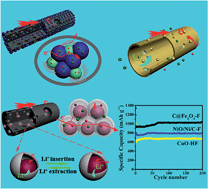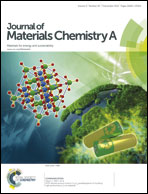Architecture-controlled synthesis of MxOy (M = Ni, Fe, Cu) microfibres from seaweed biomass for high-performance lithium ion battery anodes†
Abstract
The increasing demand for high performance lithium ion batteries (LIBs) has aroused great interest in developing high specific capacity, cycle performance and rate capability anode materials. Transition metal oxides (TMOs) have attracted much attention as promising anode materials for rechargeable LIBs owing to their high theoretical capacity. Here, a general strategy has been developed to fabricate high-performance fibrous TMO anodes such as elemental Ni doped NiO fibre (NiO/Ni/C-F), yolk–shell structured carbon@Fe2O3 fibre (C@Fe2O3-F), and hollow CuO fibre (CuO-HF) with controllable nanostructures by using alginate microfibres as templates. The key to the formation of various TMO micro-/nano-structures is the templating ability of the natural structure of long alginate molecular chains, where the metal cations can be confined in an “egg-box” via coordination with negatively charged α-L-guluronate blocks. When tested as anode materials for LIB half cells, these fibrous electrodes deliver excellent cycling performance with no capacity decrease after 200 cycles (793 mA h g−1, NiO/Ni/C-F, 0.072 A g−1; 1035 mA h g−1, C@Fe2O3-F, 0.1 A g−1; 670 mA h g−1, CuO-HF, 0.067 A g−1), and demonstrate great rate performance at different current densities. This finding highlights a general, green and eco-friendly strategy for the scale-up production of potential high-performance TMO anodes for LIBs.


 Please wait while we load your content...
Please wait while we load your content...